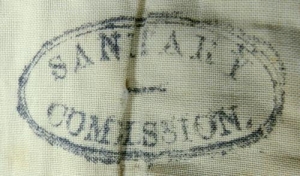Groups of volunteers organised Sanitation Fairs, in order to collect bed coverings, bandages, socks and other items of clothing for Union troops, as well as raising money for medical supplies and recruiting doctors and nurses. During such Fairs a range of meals and donated goods were sold, including quilts. In 1863, a Mrs. R. H. Hook wrote about the work of the Sanitary Commission, “[Women] have given their husbands, their sons.... This passion, not content with giving up the bread-winners… has led the women of the land to take the snowy quilts and blankets from their beds, the curtains from their windows, the hoarded linen from their presses, and send it in avalanches of comfort to our storehouses of relief.”
It is estimated that northern women made between 250,000 to 400,000 quilts for the Union Army. The quilts were the size of a hospital bed (c. 48” x 84” [122 cm x 213 cm]), and were normally made of cotton with a cotton padding. At least five of these quilts survive and are now in museum collections. One such quilt is a red, white and blue album quilt trimmed with a braided rope. It was donated by two women to the 1864 Sanitation Fair in Philadelphia, Pennsylvania (USA). The quilt is now in the Ford's Theater Museum in Washington, D.C. (USA). Each block contains the autograph of a famous northern politician or army officer, including the signatures of USA President Abraham Lincoln, Major General George McClellan and poet John Greenleaf Whittier.
The National Museum of American History in Washington, D.C. (USA) houses the Susannah Pullen quilt. It was made in Maine in 1863 by Mrs. Pullen (1816-1871) and her Sunday School class (museum acc. no. 138338). The fourteen girls in Pullen’s class worked more than 150 texts on the cotton quilt's fifteen star-patterned blocks. Bible passages, patriotic messages and riddles were among the texts, and at least one personal message: "If you are good looking send me your photograph. Direct to the name in the large square. E.G.D."
Susannah Pullen wrote a long text on the quilt: "We have many dear friends connected with the army & any proper letters from any persons embraced in the defence of our country, received by any whose names are on this quilt shall have a reply. Tell us if nothing more its destination. We meet with many others to sew for you every Wednesday and your letters would prompt us to more exertions for our patriots." She also wrote on the back: “The commencement of this war took place Apr. 12th 1861. The first gun was fired from Fort Sumter. God speed the time when we can tell when, and where, the last gun was fired; & ‘we shall learn war no more.’ If this quilt survives the war we would like to have it returned to Mrs. Gilbert Pullen, Augusta, Me . . . This quilt completed Sept. 1st 1863.” The quilt was returned to Pullen after the end of the war.
See also the TRC Needles entry on the Home of the Brave Quilt Project.
Sources:
- GREGORY, Jonathan (2008). 'Meanings and messages: Quilts to comfort the families of America’s fallen in the Afghanistan and Iraq wars', Textile Society of America Symposium Proceedings. Paper 96. [available at http://digitalcommons.unl.edu/tsaconf/96] (retrieved 27 April 2017).
- http://worldquilts.quiltstudy.org/americanstory/engagement/sanitary (retrieved 27 April 2017).
- http://civilwarquilts.blogspot.nl/2011/06/24-ladies-aid-album.html (retrieved 27 April 2017).
- http://americanhistory.si.edu/collections/search/object/nmah_556322 (retrieved 27 April 2017).
Digital source of illustration (retrieved 27 April 2017).
SA

